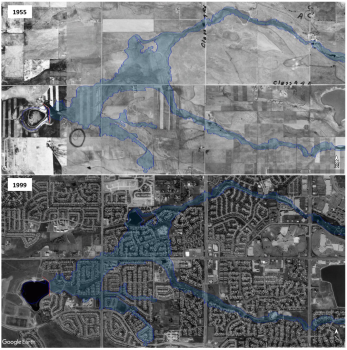Hazard Potential Classification

|
| Hazard potential can change over time. Learn more at DamFailures.org. |
“Hazard Potential: The possible adverse incremental consequences that result from the release of water or stored contents due to failure of the dam or mis-operation of the dam or appurtenances”. [1]
“Hazard Potential Classification: A system that categorizes dams according to the degree of adverse incremental consequences of a failure or mis-operation of a dam. The hazard potential classification does not reflect in any way on the current condition of the dam (e.g., safety, structural integrity, flood routing capacity)”. [1]
“Significant variations of dam classification systems exist among state and federal dam safety agencies. Despite these differences, it is apparent that each system attempts to classify dams according to the potential impacts that would result from a dam failure. One significant problem with these various systems is the use of terms that lack clear definition (e.g., ‘will cause loss of life,’ ‘may cause loss of life’). The various dam classification systems also use different terminology to define similar concepts (e.g., ‘Significant Hazard,’ ‘Moderate Hazard,’ ‘Class II,’ ‘Class B’). This hinders consistency and communication between the various federal and state agencies and understanding by the public. More consistent use of the existing hazard potential classification system is therefore recommended to support consistent application of IDF selection guidelines”. [2]
“FEMA’s Federal Guidelines for Dam Safety: Hazard Potential Classification System for Dams (FEMA P-333) was developed to address inconsistencies between the various federal and state agencies and provide recommended guidelines regarding the hazard classification of dams. This hazard potential classification system for dams is simple, clear, concise, and adaptable to any agency’s current system. The intent of this classification system is to provide straightforward definitions that can be applied consistently and uniformly by all federal and state dam safety agencies and can be readily understood by the public”. [2]
“Three classification levels are adopted as follows: LOW, SIGNIFICANT, and HIGH, listed in order of increasing adverse incremental consequences. The classification levels build on each other, i.e., the higher order classification levels add to the list of consequences for the lower classification levels”. [1]
“This hazard potential classification system categorizes dams based on the probable loss of human life and the impacts on economic, environmental, and lifeline interests. Improbable loss of life exists where persons are only temporarily in the potential inundation area. For instance, this hazard potential classification system does not contemplate the improbable loss of life of the occasional recreational user of the river and downstream lands, pass-by, or non-overnight outdoor user of downstream lands. It should be understood that in any classification system, all possibilities cannot be defined. High usage areas of any type should be considered appropriately. Judgement and common sense must ultimately be a part of any decision on classification. Further, no allowances for evacuation or other emergency actions by the population should be considered because emergency procedures should not be a substitute for appropriate design, construction, and maintenance of dam structures”. [1]
Federal Hazard Potential Classifications for Dams
“Low Hazard Potential: Dams assigned the low hazard potential classification are those where failure or misoperation results in no probable loss of human life and low economic and/or environmental losses. Losses are principally limited to the owner’s property.”[1]
"Significant Hazard Potential: Dams assigned the significant hazard potential classification are those dams where failure or mis-operation results in no probable loss of human life but can cause economic loss, environmental damage, disruption of lifeline facilities, or can impact other concerns. Significant hazard potential classification dams are often located in predominantly rural or agricultural areas but could be located in areas with population and significant infrastructure.”[1]
"High Hazard Potential: Dams are assigned the high hazard potential classification are those where failure or mis-operation will probably cause loss of human life.”[1]
Examples
![]() Learn more about hazard creep and its impact on dam safety (DamFailures.org)
Learn more about hazard creep and its impact on dam safety (DamFailures.org)
Best Practices Resources
![]() Selecting and Accommodating Inflow Design Floods for Dams (FEMA P-94), FEMA
Selecting and Accommodating Inflow Design Floods for Dams (FEMA P-94), FEMA
![]() Design Standards No. 14: Appurtenant Structures for Dams (Ch. 2: Hydrologic Considerations), USBR
Design Standards No. 14: Appurtenant Structures for Dams (Ch. 2: Hydrologic Considerations), USBR
![]() Hydrologic Engineering Requirements for Reservoirs (EM 1110-2-1420), USACE
Hydrologic Engineering Requirements for Reservoirs (EM 1110-2-1420), USACE
![]() Downstream Hazard Classification Guidelines (ACER TM 11), USBR
Downstream Hazard Classification Guidelines (ACER TM 11), USBR
Trainings
![]() On-Demand Webinar: The State of the Practice and Future of Dam Breach Modeling
On-Demand Webinar: The State of the Practice and Future of Dam Breach Modeling
Citations:
Revision ID: 7117
Revision Date: 07/11/2023
